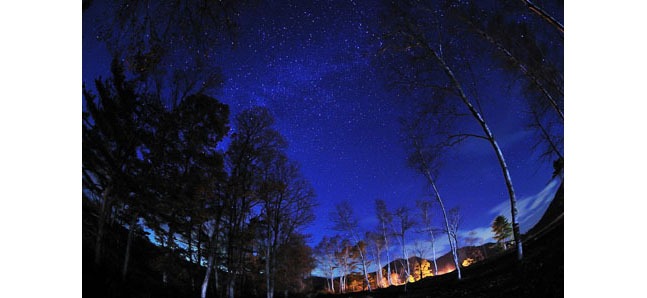
Posted: Thu Sep 16 2010
The summertime night sky can be spectacularly beautiful, with frequent displays such as the shooting stars of the Perseids meteor showers. Once autumn starts, however, the moon becomes the highlight. This year, Sunday September 22nd will be Juugoya (the full moon of September). It's time for Japanese autumn celebration Tsukimi (moon viewing).
Before then, on the evening of the 11th, you were able to see a bright, fine crescent moon with Venus and Mars drawing close, and in the early evening on Saturday the 14th, the bright star Antares, heart of the Scorpio constellation, also appeared very close to the moon. On Monday September 23rd, the full moon will be in alignment with Jupiter.
To get the maximum enjoyment from the night sky as it changes from summer to autumn, you can do more than simply look up: you can visit one of Tokyo’s planetariums. You don’t even need to go to a museum because Tokyo offers all kinds of places to sit under the stars and enjoy a drink, aroma relaxation, or even a live concert.
Planetarium Bar
This bar has its own Megastar Zero Platinum planetarium projector, which projects over five million stars. The Megastar projectors are designed by planetarium creator Takayuki Ohira, who has been devoted to making planetariums since his primary school years. It’s also possible to book parties for 20 to 30 people, so you can project the night sky onto business, wedding and birthday events. You can also treat your skin and body to their ‘Healing Facial Esthetics’ beauty treatments under the stars.
(Full details & map)
Konica Minolta Planetarium Manten
This planetarium in Ikebukuro Sunshine 60 is run directly by planetarium maker Konica Minolta Planetarium. Their latest model, the Infinium S, produces an incredibly sharp image of the night sky, with over 360,000 stars shining brilliantly down onto the viewers. Each day three films are projected at particular times on rotation. Highlights include a program about the stars narrated by celebrity Shoko Nakagawa, and the therapeutic ‘Star Forest: Hoshi-akari no Mori’, which incorporates aromatherapy and music. Sunshine City is home to restaurants, a shopping area, an aquarium and an observatory, so there’s plenty to do before and after a visit to the planetarium.
Website: konicaminolta.jp/manten/
The National Museum of Emerging Science and Innovation (Miraikan)
The sixth floor of this museum features the Dome Theatre Gaia, with its impressive dome-shaped screen. The theatre uses different projection systems to produce amazing night scenes, including Japan’s first all-sky view, super high-definition 3D system Atmos, and the Megastar II Cosmos, which can project an incredible five million stars. Throughout the day a variety of films lasting between 25 and 40 minutes are screened in the theatre, including ‘Tender is the Night’, which shows the stars seen from different regions around the world, and ‘Furusato – World Heritage Sites Viewed From Space’, which displays 3D images of natural and cultural heritage sites.
(Full details & map)
Benesse Star Dome
The Star Dome is a planetarium run by the Benesse Corporation. It’s located 100 metres above ground in Benesse’s Tokyo head office building. Around 6,500 stars are projected onto the dome-shaped screen, which has a diameter of 14m. As Japan’s first planetarium with power reclining seating, you can gaze up at the stars in the most comfortable position possible. Among the programs they screen are films featuring their popular character Shimajiro, making the planetarium a hit with kids too. The Star Dome is open on Saturdays, Sundays, national holidays and during the school spring and summer holiday periods, but it’s also possible to organize visits on weekdays for groups of twenty or more.
(Full details & map)
Hokutopia Space Yuu Planetarium Hall
This planetarium hall is on the sixth floor of Hokutopia, a multipurpose facility in Tokyo’s Kita ward which is run by the ward’s Kita-ku Culture Foundation. Programs are screened for a limited time, with a variety of shows on offer every month. Twice a month you can also enjoy watching the stars with a guided commentary from a specialist. Each screening has two parts, with a program about today’s stars and another on a monthly theme. The planetarium also hosts special concerts, so you can enjoy listening to music under a full sky of stars.
(Full details & map)
Tweets
- About Us |
- Work for Time Out |
- Send us info |
- Advertising |
- Mobile edition |
- Terms & Conditions |
- Privacy policy |
- Contact Us
Copyright © 2014 Time Out Tokyo










Add your comment